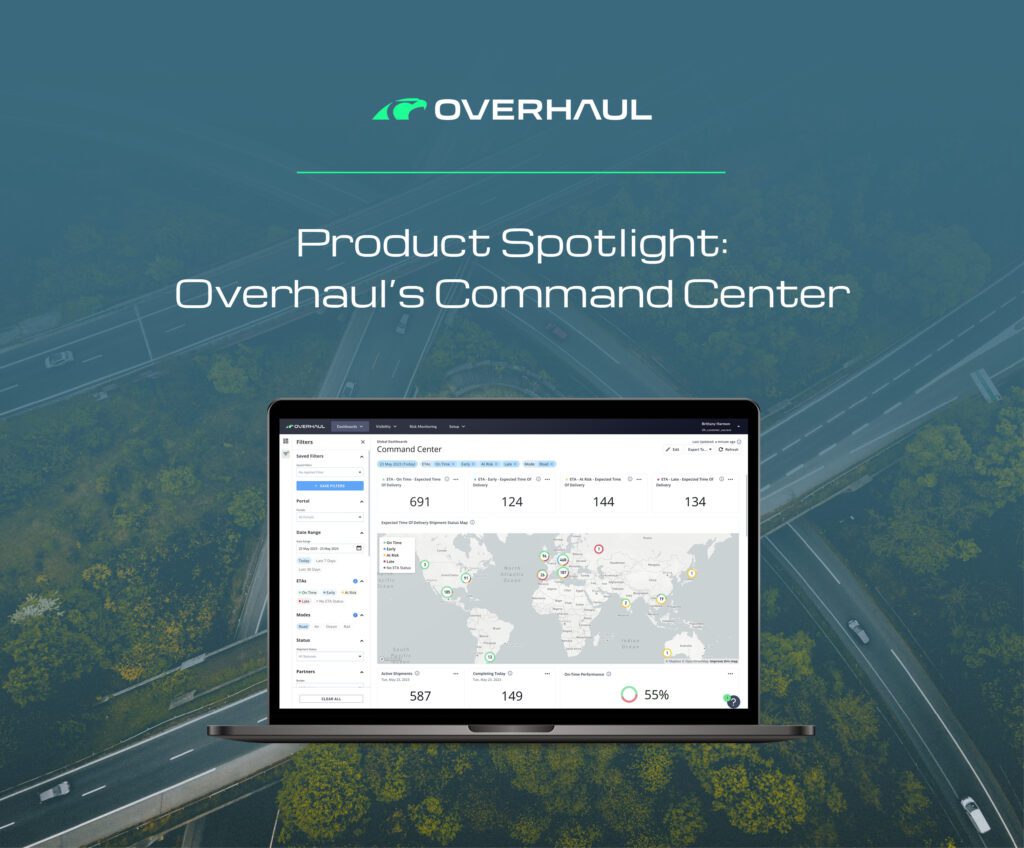ETA, shipment status, and escalated incidents: these are just some of the datapoints that help companies improve their shipments. By tracking key performance indicators (KPIs), shippers can better understand what’s working about their shipments, what’s not, and why. To visualize these datapoints, they need the help of a logistics KPI dashboard, and not just any dashboard will do.
With Overhaul’s Command Center, companies can have insight into not only their logistics KPIs, but also security and quality KPIs.
What is a quality, security, and logistics KPI dashboard?
A logistics KPI dashboard allows you to track and share specific metrics across your teams. These metrics help drive decision-making and provide insight into your products’ supply chain journey. You can also see your data in real-time, as well as compare that data with past metrics.
Logistics KPI dashboards make it easier to reduce downstream impact, save time and resources, and evaluate progress in real-time. They also help keep stakeholders up to date on the latest processes and progress of their shipments.
While most real-time-transportation companies only offer insight into logistics KPIs, Overhaul’s Command Center also serves as a quality and security KPI dashboard. An industry-first, the Command Center enables customers to make data-driven decisions and track critical KPIs. These KPIs, coupled with logistics KPIs, present a holistic picture of how well a company is meeting its goals.
The Overhaul Command Center empowers your business with powerful at-a-glance metrics. You can measure your key performance indicators and discover insights to drive actionable and intelligence-driven decisions.
Our user-friendly logistics KPI dashboard helps you protect your products’ safety and on-time performance. By consolidating your product and shipment data with your supply chain logistics data, you’ll gain granular visibility down to SKU level.
The Command Center also helps you stay focused on the most key issues at stake. Our advanced filter capabilities allow you to specify shipment locations, modes, statuses, involved stakeholders, and more. This makes it easy to present your most relevant information via an easily comprehensible view.
How to measure logistics performance with Overhaul’s Command Center
Picking your KPIs
Different companies will have different goals for their shipments, which means they’ll want to track different KPIs. When deciding how to measure logistics performance, the first step involves deciding which KPIs you want to track.
Datapoints can generally be broken up into logistics metrics, compliance metrics, and risk metrics. Logistics metrics can encompass everything from carrier compliance to ETA. Compliance metrics are concerned with ensuring that everyone who handles your shipment remains compliant. Lastly, risk metrics are meant to help you avoid risk by understanding potential hazards and losses.
Overhaul’s Command Center is configurable, so you can turn on and off the KPIs that matter most to you and save them in a unique view. With the addition of our Save As feature, users can now create, name, and save an unlimited number of dashboards. These dashboards can include a logistics view, security view, or a mix to help you check on the shipments that need your attention. With Save As, customers can better focus their work and gain a competitive advantage.
Another new feature, Share, allows you to share individual dashboards across your company. With the powerful combination of Save As and Share, you can create a custom view, save it, and share it with colleagues. This view — whether it be logistics-focused, security-focused, compliance-focused, or a combination — helps colleagues better understand and address critical business concerns.
Tracking and analyzing KPIs
Once you’ve chosen your KPIs, it’s time to start tracking them. Some dashboards offer more visibility than others, and you’ll want to ensure the one you’ve picked can track your chosen KPIs. You’ll also want to make sure the dashboard is easy to use and intuitive. If your team can’t figure out how to use it, it doesn’t matter how much it can (theoretically) do for you.
When tracking KPIs, it helps to have specific dates and goals in mind. You’ll also want to consider what makes a goal doable and realistic. This isn’t a one time process, and as mentioned before, it’s likely that your business-critical KPIs will change over time. For this reason, it’s important to routinely assess what information your KPIs offer and how to use this information going forward.
Our recent Command Center features have made it even easier to sort through your data and understand how your performance is tracking over time. For example, Command Center also allows you to Save Filters to direct you straight to the data you need to get to work faster. After you’ve created your personalized dashboards, you can save the filters on each dashboard and see your most frequented views in a single click. Combined with Save As, Save Filters helps users become even more productive. Whether you’re applying saved filters to see data for mode, status, or risk event, you can now build on your biggest priorities from the start.
Once you have this data, you can use it to help figure out what steps you need to take to prepare against future disasters. With additional features like Overhaul’s new in-app Insights, an exclusive repository of all of Overhaul’s best-in-class cargo crime intelligence material, you’ll be even better equipped to handle risk and logistical issues as they happen in real-time.
Updating your process
If you’re not hitting the goals you’ve set for your KPIs, it might mean it’s time to update your process. This could mean switching out personnel or technology or entirely overhauling your shipments.
Of course, big changes like these require support, which Overhaul is eager to offer. From tracking KPIs to taking steps to better hit those KPIs via carrier performance in Command Center, we have the tools and expertise to help.
Overhaul’s Command Center also enables you to take monthly business reviews to the next level with instantly compiled data. You can then present meaningful visuals to your teams to drive growth and operational performance. In short, the Command Center helps you better understand your logistics activities so you can improve your logistics processes. As a result, customer satisfaction improves and supply chain management becomes much easier.
Command Center and logistics KPI dashboards – a summary
A logistics KPI dashboard does more than help you track your KPIs. It also helps you understand what your company is doing well and where it needs to improve. In this sense, logistics KPI dashboards can help improve order accuracy, transportation costs, delivery time, and overall logistics management. But if you’re unable to track security and quality KPIs, you’re not seeing the full picture of what’s happening to your shipments in-transit.
Overhaul is challenging the status quo and providing a birds-eye view of the supply chain ecosystem. Our Command Center makes it easy to identify problems and cultivate solutions. To learn more about how our Command Center help you use granular data to track the success of your program with quality, security, and logistics KPIs, reach out to us today. And if you’re interested in learning about the rest of Overhaul’s products, stay tuned for our next product spotlight.





